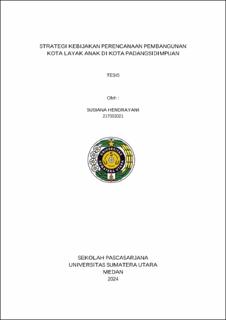| dc.description.abstract | A friendly city is a city that can plan, determine and carry out all development
programs oriented to child and obligation, So that, the children can grow and
develop properly. To create a such policy of a child friendly city, an important first
step is to develop strategic planning both holistic and integrated ensured all
decisions and initiatives considered children needs, wishes and rights as a core of
sustainable development urban. The purpose of the study is to analyze the strategy
of policy on child friendly urban development planning in Padangsidimpuan
Municipality firstly and second one is to determine the supporting and obstacle
factors of the mentioned policy strategic. This research used quantitative method
by using SWOT analysis tools, Analysis Hierarchy Process (AHP) and Chi-square.
The results showed that the proper strategies were being used in the strategy of
policy on child friendly urban development planning in Padangsidimpuan
Municipality, namely (1) Padangsidimpuan Municipality allocated budgets, human
resources and involved village fund allocation. (2) The district had regulation and
optimized utilization of all child friendly urban supporting facilities. (3) The district
optimized the role of institution supervising children’s area. Government
commitment, human resources and budge were the factors influenced the strategy
in a child friendly implemented. The supporting and obstacle factors were
regulatory and adequate facilities, the stakeholder involvement in the task force,
potential threats to children, unhealthy environment and lack of coordination. The
calculation of chi square test analysis with Asymp.Sig value of 0.048 was smaller
than 0.05, interpreted as a significant relationship between supporters and
obstacles to the child-friendly city strategy in the city of Padangsidimpuan | en_US |


